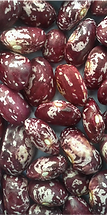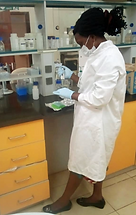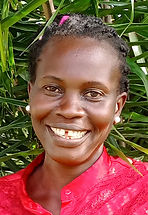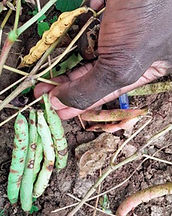Genetic improvement of biofortified common bean varieties in Uganda for multiple disease resistances using marker assisted backcrossing


Collecting seed of breeding lines with Pythium root rot resistance (2022).
PROJECT OVERVIEW
Background
Common bean (Phaseolus vulgaris) is the main protein source for over 80% of the population in Uganda, and this crop plays a key role in food and nutrition security in many households. However, good nutrition requires not only an adequate consumption of calories and proteins, but also of essential micronutrients such as iron and zinc, in particular for children below 5 years of age and for women of child-bearing age.
In an effort to decrease micronutrient deficiencies in resource-poor households, the Ugandan National Agricultural Research Organisation (NARO) released in 2016 five bio-fortified bean varieties with higher iron and zinc contents. However, these varieties succumb to a range of diseases, and for this reason their production and productivity is stifled.
The KT-supported NaCRRI bean improvement project aims to introduce multiple disease resistance to two biofortified elite bean varieties, NAROBEAN 3 and NAROBEAN 4C, through marker assisted selection. The target diseases are anthracnose (ANT), and Phythium root rot disease. The donors for resistance to these diseases are advanced breeding lines developed in the previous phases of the KT-funded bean improvement programme in Uganda.
The project also aims to establish the genetic diversity in Uganda of Colletotrichum lindemuthianum, the causative agent of ANT, and to identify new sources of resistance to this disease.
Objectives
-
To characterise and preserve Colletotrichum lindemuthianum isolates
-
To identify new sources of anthracnose resistance genes.
-
To identify and validate disease resistance sources for anthracnose and Pythium root rot and the available resistance linked markers.
-
To develop populations combining the resistance traits into the background of biofortified bean market classes using marker assisted selection.
-
To conduct phenotypic and genotypic evaluation of the improved biofortified resistant lines for introgressed resistance genes.

Preliminary yield trials of improved disease resistant bush bean varieties (derived from NABE 12C), Nampijja, 2020.
Progress to date
-
The collection of Colletotrichum lindemuthianum samples has been completed. 172 isolates have been preserved. Pathogenicity tests are ongoing. This work is being conducted by Mr Allan Nkuboye.
-
In order to identify new sources of ANT resistance, 90 local landraces and 201 introduced varieties have been planted to produce enough seed for four field trial locations. This work is being conducted by Ms Prossy Namuli.
-
Molecular and phenotypic analysis (using the detached leaf method to assess resistance to ANT, and artificial inoculation with Pythium ultimum var ultimum (Ms 61) to determine susceptibility to root rot) of the advanced breeding lines derived in the previous phase of the project confirmed that they can be used as sources of disease resistance to improve NAROBEAN 3 and NAROBEAN 4. These are backcross lines derived from NABE14 and G2333 (a donor variety for ANT resistance) and from NABE12C and RWR 719 (a variety resistant to Pythium root rot).
-
The molecular markers to target ANT and root rot disease resistance genes to improve in NAROBEAN 3 and NAROBEAN 4C have been tested and validated.
-
The generation of the fourth backcross, BC4F1 to transfer anthracnose (Co-5, Co-42) and Pythium root rot resistance genes into NAROBEAN 3 and NAROBEAN 4C is on-going.

i

ii

iii

iv

v
NAROBEAN 3 (i); and NAROBEAN 4C (ii); Reaction of selected bean varieties to artificial infection with Pythium ultimum var ultimum, the causative agent of root rot; the plants were uprooted 21 days after planting (iii); Ms Nampijja making crosses in the screen house to develop the backcross breeding populations (iv); testing the mapping population for the presence of the markers linked to disease resistance (v).
Participatory evaluation and release of new bean lines with improved disease resistance to anthracnose and Pythium root rot
Background
The previous phase of the work of the KT-funded bean improvement programme in Uganda aimed to introduce multiple diseases resistance (to anthracnose, Pythium and angular leaf spot) in two commercial bean varieties: NABE 12C and NABE 14. The current project aims to advance this work and test a selection of advanced breeding lines previously developed in order to identify candidates for the eventual release of improved varieties.
Progress to date
-
Two preliminary yield trials (PYTs) were established in two locations in Sheema and one in Kabale during the 2020 second season. Promising lines for both bush and climbing beans have been identified.
-
In addition to PYT’s, seed increase of the backcross derived lines was conducted at Sheema.
-
Selections from the PYT 2020 second season were tested in the intermediate yield trial (IYT) during the 2021 first season in two locations in Sheema and one Kabale, and also tested on-farm.
-
Promising lines identified: UGKT-B133, UGKT- B157 – 4, UGKT- B73 and UGKT-B157 – 7 for bush beans; UGKT- KS1 649, UGKT- KS1 41-5, UGKT- KS1 1073-1, KS1 299-8 for climbing beans. These lines are currently undergoing DUS tests (distinctness, uniformity and stability) for their eventual release as improved varieties.

i

ii

iii
Preliminary yield trials for the NABE 12C derived disease resistant lines 2021 (i-ii); farmers receive seed samples of a selection of the advanced lines to test them in their farms (iii).
PROJECT TEAM MEMBERS

Dr Stanley Nkalubo
Principal Investigator, National Crops Resources Research Institute (NaCRRI), Kawanda, Uganda.
Dr Annet Namayanja
Co-PI for the grant "Participatory evaluation and release of new bean lines with improved disease resistance to anthracnose and Pythium root rot", NaCRRI, Kawanda, Uganda.

Ms Jane Mukabaranga
Principal technician / breeder

Ms Shakirah Nampijja
Technician


Mr Amos Acur
Pathology technician
Mr Allan Nkuboye
MSc student, Makerere University, Uganda

Ms Prossy Namuli
MSc student, Makerere University, Uganda
STUDENT PROJECTS
Distribution and characterisation of bean anthracnose pathogen, Colletotrichum lindemuthianum in the major agro-ecologies of Uganda
Background
Bean anthracnose (caused by the fungus Colletotrichum lindemuthianum) is currently present in most of the bean growing regions of Uganda, and its distribution is believed to be expanding. The spread of this disease to new areas may be attributed to climate change and to the movement of seed within the country and from other countries. The distribution of this pathogen from where it has been known to occur (the cool humid highland areas such as Kisoro, Kabale, Sironko and Kapchorwa) to non-traditional low to mid altitude warmer regions such as the Mid-north, Mid-west, Teso, and the West Nile region may have resulted in the emergence of new races adapted to the different agro-ecological conditions of the new locations. There have been no studies on the diversity of C. lindemuthianum in Uganda in the last 6 years.
Project objectives
-
To map the current prevalence of bean anthracnose in Ugandan common bean agro-ecologies.
-
To determine the virulence of C. lindemuthanium isolates from Ugandan common bean agro ecologies and identify races of the pathogen.
-
To determine the genetic diversity of C. lindemuthanium causing bean anthracnose in Uganda
Progress to date
-
Sample collection of C. lindemuthianum in 25 Uganda districts has been completed from diseased leaf samples and 172 isolates have been preserved.
- For the pathogenicity tests 51 isolates were screened on 12 differentials and two susceptible checks (K132 and NABE14). Symptoms were evaluated following the CIAT severity scale (1-9).
-
11 races were identified as the most virulent, and 2 races as the most prevalent.

Mr Allan Nkuboye isolating spores for the purification of the C. lindemuthanium isolates sampled.
Mr Allan Nkuboye
MSc student, Makerere University, Uganda.
Supervisors: Dr Pamela Paparu NACRRI, and Dr Shahasi Yusuf Athman and
Dr Patience Tugum, Makerere University.

i

ii

iii

iv

v
Bean pods infected with ANT (i); location of the collection sites of bean anthracnose samples in Uganda (ii); a lobate C. lindemuthianum colony (iii); plants artificially infected with C. lindemuthianum 031A (iv); a plant infected with isolate 205 seven days after artificial infection (v).
Identification of new sources of resistance to bean anthracnose among the local and introduced common bean (Phaseolus vulgaris) germplasm in Uganda
Ms Prossy Namuli
MSc in Plant Breeding and Seed Systems, Supervisors: Dr Stanley Nkalubo (NaCRRI), Dr Geoffrey Tusiime, Makerere University, Uganda.

Ms Prossy Namuli
Background
Bean anthracnose (ANT) is responsible for yield losses between 20 -100%. The causative agent of this disease is a fungus, Colletotrichum lindemuthianum, originally restricted to the cool and humid regions of the Western and Eastern highlands of Uganda but now found in all the agro-ecologies of the country. C. lindemuthianum is highly variable, with new races emerging continuously. Known sources of resistance to ANT include the bean varieties G2333 and AB136, but some races of C. lindemuthianum have managed to overcome the resistance. The high rate of mutability of this pathogen leads to a breakdown of single gene host resistance, and therefore a strategy to increase broad broad-spectrum resistance against C. lindemuthianum is to combine in the same bean variety different sources of resistance. One potential source of new resistance is locally adapted landraces and introduced lines. These have not been comprehensively screened for resistance to ANT, and there is also insufficient information on the interaction between genotype and environmental factors effect on the incidence of ANT.
Project objectives
-
To identify new sources of resistance with broad resistance to the most virulent pathotypes of C. lindemuthianum.
-
To determine Genotype by Environment interaction of resistant candidates for resistance to C. lindemuthianum and yield under natural infestation.
Progress to date
-
The collection and seed multiplication of the germplasm has been completed: 290 bean lines (200 landraces and 50 introduced lines).
-
Multi-location evaluation of these varieties under natural infestation is underway in four field sites with different agroecological conditions: Kabale, Rwebitaba, Arua and Bulengeni.

i

ii

iii

iv
The seeds of the plant varieties to be tested (i); field trial site at Sheema, 2021 (ii); Ms Namuli during field work during harvesting (iii); Ms Namuli cultivating the isolated C. lindemuthianum races (iv).
Videos
Video report, NaCRRI Uganda.
PROJECT LOCATIONS
Locations of the NaCRRI bean breeding project trial sites.


